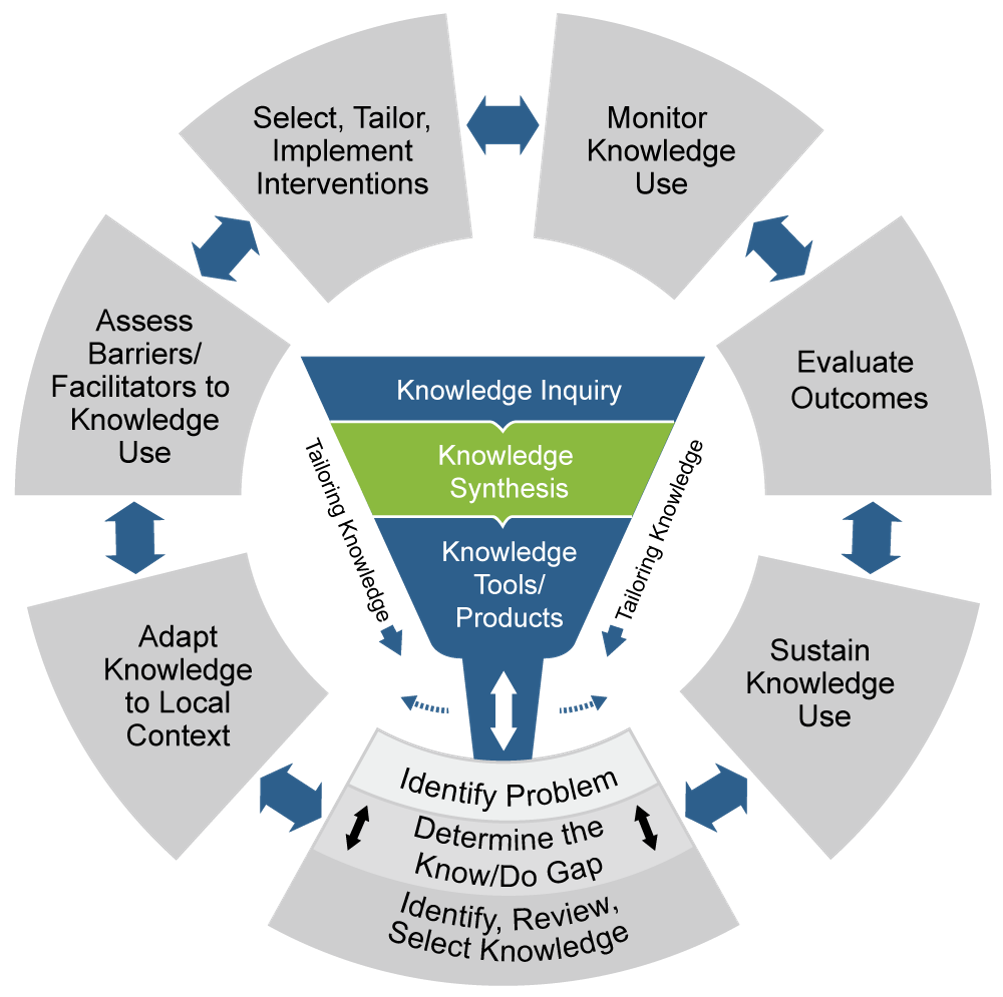What is Knowledge Translation?
The Canadian Institute of Health Research has one of the most well-known definitions of knowledge translation.
"Knowledge translation is defined as a dynamic and iterative process that includes synthesis, dissemination, exchange and ethically-sound application of knowledge to improve the health of Canadians, provide more effective health services and products and strengthen the health care system.”
Translating the Evidence into Practice
Translation - Moving the best evidence into professional practice. The purpose of translation is to provide the best outcomes and value, and lower risks to our patient population.
Steps involved in Translating the Evidence into Practice:
- Set the goals
- Assemble a team
- Develop a PLAN - determine key stakeholders, expertise & support
- Anticipate barriers & facilitators
- Measure/collect data - baseline, process, outcomes, expenses
- Gain support & approval
- Implement - DO - pilot roll-out, educate, support, navigate
- Monitor - STUDY - observe & measure
- Manage & Adjust - ACT - Adapt, Adopt or Abandon based on evidence
- Sustain & Grow - Share the results, get feedback, embed in standards or policies, spread more broadly
- Celebrate the work you have accomplished!
Knowledge to Action (KTA) Framework
The Knowledge to Action (KTA) Framework is used for facilitating the use of research knowledge by several stakeholders, such as practitioners, policymakers, patients and the public. The KTA process has two components: Knowledge Creation and Action.

Adapted from Graham 2006 (https://pubmed.ncbi.nlm.nih.gov/16557505/) by Crockett 2017 (https://medium.com/knowledgenudge/kt-101-the-knowledge-to-action-framework-7fbe399723e8)
Knowledge Creation includes knowledge inquiry, knowledge synthesis, and knowledge tools/products. Knowledge becomes more refined as it moves through these three steps.
Action includes identifying and appraising the problem and the known research, identifying barriers and successes, planning and executing, and finally monitoring, evaluating, and adjusting.
In summary, KTA is applying knowledge to real life situations.
How Can Knowledge Translation Be Applied to Program Planning?
When thinking about program planning and implementation, there are several important concepts that need to be considered.
- Health Impact
Ask: What will be the health impact of the desired outcomes?
- Economic Evaluation
Ask: How much would the project cost to implement? Is the investment offset by the outcomes (is it worth it?)
- Coordinated Implementation
Ask: What community groups could/should be involved? What outside influences are present?
- Factors for Success
Ask: Do I have buy-in/support from involved parties? Do I have a plan for timely feedback? Have I created a non-punitive environment? Have I done all I can to encourage and active exchange during feedback?
Program Implementation
Program implementation “involves the activities of putting the program into place, from gaining acceptance for the program to making revisions when the program is not working as planned” - (Ervin, N. Advanced community health nursing practice: Population focused care. Upper Saddle River, NJ: Prentice Hall. 2002).
5 Phases of the Dignan & Carr Program Implementation Model:
-
Gaining acceptance of the program.
-
Specifying tasks and estimating resource needs.
-
Developing specific plans for program activities.
-
Establishing a mechanism for program management.
-
Putting plans into action.
(Dignan, M.B & Carr, P.A. Program planning for health education and promotion. 2nd ed. Philadelphia: Lea & Febiger. 1992)
Articles of Interest
A few free articles for further reading...